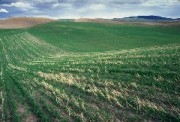| |
|
You might not know it, but you
probably eat wheat every day.

If you eat bread, cereal, crackers, noodles, cakes and cookies then you
do! Harvested wheat seed, or grain, is ground into flour and used to
make many of the things we eat. Read the ingredients on your cereal,
cracker, cake and noodle boxes. Can you find any that do NOT
say wheat flour?
Keep reading to find out how a wheat
plant grows.
Winter wheat seed is planted in the fall and
needs moisture (water) to sprout and grow. The first thing to happen is
the seed will swell up as it soaks up the moisture in the soil. Then the
seed develops a seminal root system, which
helps the main stem get food (nutrients) and water from the soil. Next the
seed will send its first leaf toward the soil
surface. The first leaf is inside a leaf-like structure called the coleoptile, which protects the leaf as it
pushes its way up through the soil. When the coleoptile breaks the soil
surface, it splits open and the first leaf of the main stem emerges.
Depending on the air temperature and how deep the seed was planted, it
takes 10 to 14 days for the first leaf to emerge from the soil.
As the plant develops and more leaves are produced, we found that the
leaves alternate from one side of the main stem to the other side. That
means if you
 hold
a plant in your hand with leaf one, or L1, on
your right, the second leaf, or L2, will be
on your left, leaf three, or L3, will be on
your right and leaf four, or L4, will be on
your left, and so on. The plant has what we call an odd side and an even
side; all odd numbered leaves are on one side, even numbered leaves on the
other side. It is common for wheat plants in the Northwest to develop up
to 12 leaves on the main stem. Another root system, the nodal roots, develops when the main stem has
three to four leaves. hold
a plant in your hand with leaf one, or L1, on
your right, the second leaf, or L2, will be
on your left, leaf three, or L3, will be on
your right and leaf four, or L4, will be on
your left, and so on. The plant has what we call an odd side and an even
side; all odd numbered leaves are on one side, even numbered leaves on the
other side. It is common for wheat plants in the Northwest to develop up
to 12 leaves on the main stem. Another root system, the nodal roots, develops when the main stem has
three to four leaves.
At the base of each leaf and the coleoptile, there is a bud that can
develop into a tiller, or branch. We name
these tillers according to the leaf base they grow out of. Tiller one, or T1, grows from the base of L1, tiller two, or T2, grows from the base of L2,
and so on. The tiller that grows from the base of the coleoptile is named tiller zero, or T0. The nodal roots help
these tillers get food and water from the soil.
The main stem and each tiller has the potential to develop into a mature
stem. That stem holds the head, which contains the wheat seed. How much
moisture (water) and many nutrients (food) are available for the plant are
two things that can decide how many tillers on a plant will develop a
head. The winter wheat in our area averages three heads for each plant.
Each head contains about 20 seeds. When the heads are mature and dry,
sometime in mid-July, the farmer harvests (cuts) his fields with a combine
and the crop year is over. Spring wheat grows the same way, only it is
planted in the spring and is harvested in early to mid August.
|
|



 |


